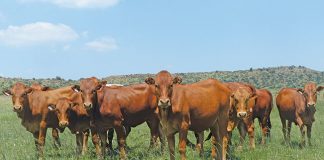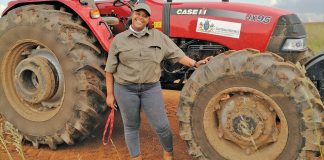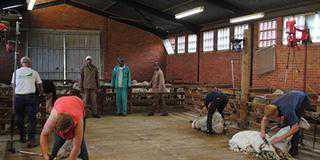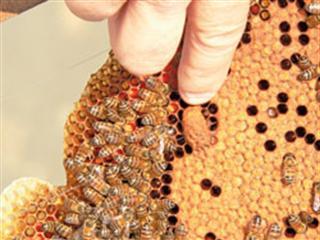
Walking around on a hot day sweating heavily in a thick suit, with angry bees trying to find a way in to punish this human intruder cannot be one of life’s more pleasant experiences. Yet dedicated beekeepers do this almost daily in their quest for top quality honey to meet a growing consumer demand. Crop farmers are also increasingly hiring beekeepers – or apiarists – to use their miniature livestock to pollinate various crops and fruits.
In fact, it’s said that should all the world’s bees suddenly die, famine would soon follow. Apiarist Craig Campbell of Hilton, KwaZulu-Natal, became interested in apiculture after spending time with his brother-in-law, Alastair Smith, who keeps bees as a hobby. Starting out with one hive in 1992, the former sales representative soon grew his apiary to 400 hives. At this point he went into beekeeping full-time.
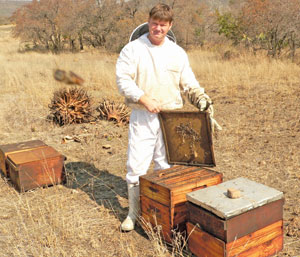
‘Don’t be scared to ask for help. Most experienced beekeepers are very willing to offer advice,’ are Craig Campbell’s words of wisdom to aspiring apiarists.
Craig now has 4 500 hives, each with 20 000 to 100 000 bees depending on the season and the hive’s stage of development.
“My main income from the bees is from honey and from hiring my bees out to pollinate crops in KZN and the Free State,” he explains. “I produce about 50t of honey a year and I supply it to commercial bottler Peel’s Honey in Howick. “The crops my bees currently pollinate include apples, cherries, macadamias, avocados, litchis and sunflower.”
There are generally three distinct working seasons with bees, the times varying slightly from year to year. Hive maintenance and preparation typically take place in June and July, the pollination season from the end July to the end of October, and the honey production season from September to May.
Balanced diet
The healthiest and strongest hives, each with at least six brood frames, are used for the pollination service. Brood frames hang in the lower section – or brood chamber – of the hive. They provide bees with a place to hatch eggs, feed larvae and house the pupae from which young bees emerge. A healthy brood frame has large numbers of eggs and larvae, as well as nectar and pollen to feed the growing young.
At least six healthy brood frames in each hive are used for pollination work to guarantee a steady supply of bees to replace any that are lost or die during the pollination period, which lasts up to six weeks. “To get my hives ready for pollination work, I take the approximately 1 500 hives needed to areas around Weenen with dense wild aloe populations and citrus orchards,” explains Craig.

A typical healthy brood frame. The closed chambers house bee pupae, the orange-coloured chambers store aloe pollen and the chambers surrounding these store honey.
During these two months – June and July – the bees gather protein-rich pollen from the aloes and citrus trees. Craig also feeds them a sugar water solution to provide the carbohydrates they need, but which are in short supply in the wild at this time of year. “Bees need a balanced protein and carbohydrate diet to stay healthy,” he notes.
The sugar solution consists of 75kg white sugar and 210l water. The 1 500 hives at Weenen will consume about 1 000l of this mixture a day. With his hives in groups fairly close to one another during this period, Craig and his workers take the opportunity to repair hives damaged by human honey thieves and vandals when the hives are in other places. They also hire guards to protect the hives 24 hours a day.
Management
At the same time, they implement hive management and hive manipulation. Hive management includes checking for pests and diseases, common and feared problems for today’s beekeepers. The most serious diseases include American and European foulbrood. Then there’s the possibility of invasions by the Cape honeybee (Apis mellifera capensis). These disrupt breeding in honeybee (Apis mellifera scutellata) hives.
Fortunately, Craig has none of these threats in his hives, but he has to deal with more common pests and diseases in his day-to-day management. It’s crucial for Craig and his colleagues, Don Roberts and Robert Young, to remain updated on what’s out there and to be alert. “I spent four years in Australia from 2006. It has a massive apiculture industry and what I learnt there is valuable for my business here,” continues Craig.
“If we find any pest or disease in a hive, we immediately move the hive to a quarantine site where we give it a detailed inspection and treat it accordingly. If we found American foulbrood in a hive, we would wait until nightfall when the hive’s bees have all returned and then burn it.” One aspect of hive manipulation, meanwhile, involves ensuring there’s enough space in each hive for the queen to reach each brood frame to lay her eggs.
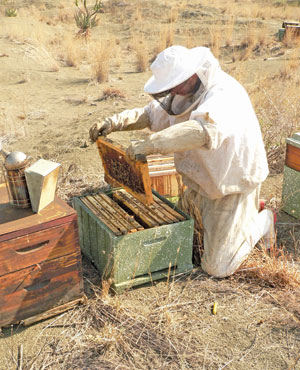
Robert Young inspects a hive for disease. Some bee diseases, such as American foulbrood, are a grave threat to the industry and have been declared notifiable diseases. Infected hives must be burnt to stop the disease from spreading.
Craig’s hives go straight to Weenen from forage sites around KZN, where bees have been collecting nectar to make honey. When they get to Weenen the hives are brimming with honey. Most of this is contained in ‘super frames’, which hang in the top part of the hive, called the ‘super chamber’. If the super chamber is full, the bees will start building honeycombs anywhere else they can find, including the brood frames.
To avoid this, Craig and his team immediately collect all the honey from the super chamber as well as excess honey in the brood base as soon as the hives arrive back in Weenen. They then remove the brood frames and replace them with foundation frames made from recycled beeswax. These form the substrate that encourages the bees to build a new brood comb in which the queen can lay the eggs of a new generation of bees.
Pollination
Craig has around 24 pollination clients in KZN and the Free State. Specific formulae calculate how many hives per hectare are needed for each crop being pollinated. For example, macadamia orchards typically require five to seven hives per hectare and apple orchards about two to three hives per hectare.
Craig’s smallest current order is for 20 hives, and the largest for 200, with each hive containing at least 60 000 bees. It is of course impossible to count every bee, but Craig, Don and Robert can fairly accurately visually appraise the number of bees in a hive.
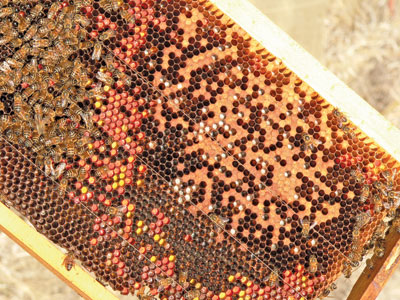
Busy as a bee. A kaleidoscope of colour and activity on a brood frame.
Transporting the hives to and from each client is a job in itself. Bees are active during the day, with most of the worker bees flying to and from their hives to collect nectar and pollen. When it starts cooling down in the late afternoon, the bees will begin to return. This is the ideal time to load, transport and offload hives destined for pollination work. “For smaller orders I use a bakkie and trailer to transport the hives, and for larger orders an 8-ton truck,” says Craig.
“Our furthest client is 350km away, so we start loading his order at Weenen as soon as the sun sets. Offloading at his place usually starts around midnight and must be finished before sunrise. “Positioning the hives at a pollination site can be simple or complicated, depending on where a client wants them situated.
“All I expect from a pollination client over the maximum of six weeks my hives will be on the site is that he does everything possible to prevent theft or vandalism, and doesn’t spray pesticides near the hives. A good business relationship with each client is essential.” During the pollination season, nectar is usually scarce and the bees tend to have a hard time as a result. So Craig and his team to try to build up colony strength by feeding the bees sugar water.
Honey production
The key areas for Craig’s honey production are sunflower lands in the Free State, citrus orchards in KZN, and blue gum plantations in the KZN Midlands. Having so many hives placed on so many sites increases the threat of honey theft and hive vandalism. But Craig relies on the landowners to inform him of problems. When it comes to sunflowers, he will only place hives at sites where non-genetically modified crops are grown as GM sunflower crops don’t provide nectar for bees to use for honey production.
Craig decides how many hives to place at a particular bee forage site according to the honey production potential of the targeted flora species in the area. “Due to variations in climatic conditions, no one crop is particularly better than another for honey production,” he explains. “I use past experience on the performance of the bees at a specific forage site to decide on whether to place hives there again, or to move to a new forage site. Climate and other factors such as environmental disturbance can also turn a usually productive site into a poor one.”
Hard work
The potential to make good money from bees is there, says Craig. But, he adds, apiculture is very hard work. Being stung by bees every day is just one of the things you can look forward to as an apiarist. “It looks like a simple enterprise, but it’s far from it,” says Craig. “It requires dedication and passion.” He advises aspiring apiarists to join a local beekeepers’ association and learn more about the industry from experienced beekeepers. He suggests that newcomers either start small and grow as they gain experience, or first work for an experienced commercial apiarist until they have enough experience to go out on their own.
Local is Preferred
“The local honey industry produces nowhere near enough to meet national demand, and honey has to be imported to fill the shortfall,” says Craig. “But I have found that true honey lovers prefer locally produced honey to imported honey. So, the market for locally produced honey has much room to grow and has space for new entrants.” While it may not be dauntingly expensive to establish a commercial apiary, Craig explains that the daily running costs, especially transport and labour, can be prohibitive and must be carefully managed.
Finding safe and suitable bee forage areas can also be challenging. Many landowners must be won over before they will allow apiarists to use their land as hive and foraging sites. For this reason Craig is very strict on his staff about abiding to the landowner’s rules about the use of land for placing hives. This approach reduces the risk of Craig losing a productive site because of a landowner withdrawing permission for hives to be placed there.
Craig accepts that he’ll lose about 10% of his total bee population annually due to mortality and other natural factors such as swarming behaviour, when the bees in one of his hives find a new home elsewhere. He replaces lost stock by breeding replacement queen bees either by splitting an existing single hive into two, or by catching wild bee swarms in a catch box baited with bees wax and propolis (a mixture of beeswax and resins collected by the honeybee from the flowers and leaf buds of plants).
He summarises the apiarist’s approach: “Our job as beekeepers is to make the bees’ lives easier so they can work more efficiently and effectively for us. “We never really own our bees; they are free to swarm and find a new home whenever they want to.”
For more information contact Craig Campbell at: 084 774 8692, or [email protected]











